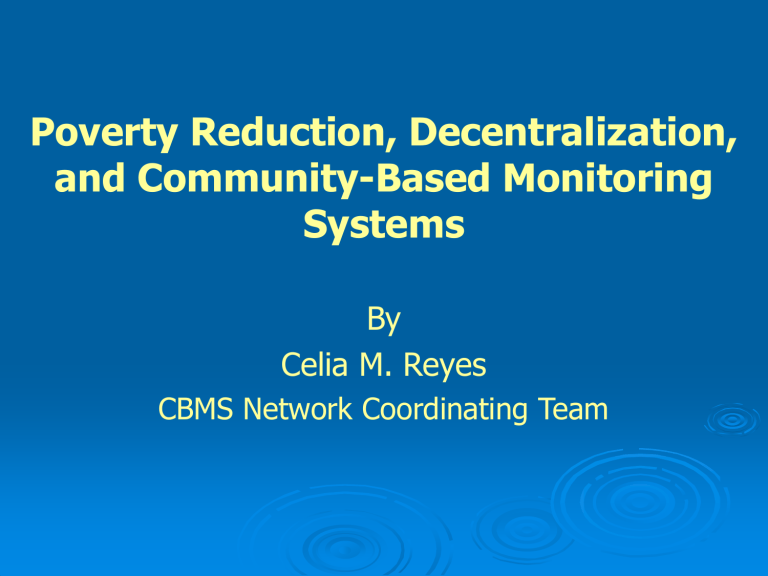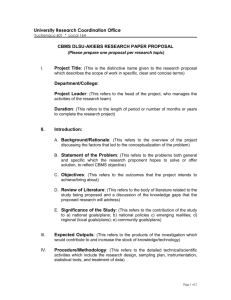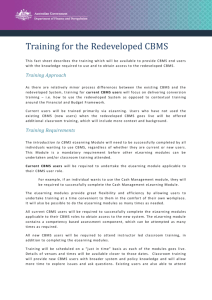Presentation
advertisement

Poverty Reduction, Decentralization, and Community-Based Monitoring Systems By Celia M. Reyes CBMS Network Coordinating Team Outline of Presentation Objectives Decentralization and its challenges Poverty monitoring systems Role of CBMS Concluding remarks Objectives Identifies the challenges brought about by decentralization Examines the role of community-based monitoring systems in addressing the demand for more disaggregated data on the different dimensions of poverty. Decentralization Parallel to the poverty reduction efforts of many countries is the change in governance structure. Decentralization has gained popularity within the last two decades. Has been advocated and practiced in several countries in Asia. Defined as the transfer of responsibility for planning, management and resource generation and allocation, from the central government and its agencies to lower levels of government. Rationale for Decentralization Seen as an alternative to provide public services in a more cost-effective way. Improve the delivery of services. Make the government more responsive to the needs of the people. Make local units more accountable to their constituents. Decentralization in the Philippines Passage of Local Government Code (LGC) in 1991 represented a major step in decentralization. Before the LGC, LGUs’ main functions were: Levying and collection of local taxes Regulation of business activities Administration of garbage collection, public cemeteries, public markets and slaughterhouses The LGC paved the way for increased local autonomy, expenditure responsibility and revenue authority. Principal responsibility for the delivery of basic social services and the operation of the facilities were devolved to LGUs. Decentralization in the Philippines Devolved areas are: Agricultural extension and research Social forestry Environmental management and pollution control Primary health and hospital care Social welfare services Repair and maintenance of infrastructure Water supply and communal irrigation Land use planning Decentralization in the Philippines LGUs were given taxing authority to be able to generate allotment that they get from the National Government. A new scheme has been devised to determine the sharere of LGUs from the revenues collected by the national government and this is based primarily on population and land size. Challenges of Decentralization Decentralization brings decision-making closer to the people and consequently, may yield programs and services that better address local needs. However, this requires sufficient and technical capacity on the part of local government units, as well as supporting institutional arrangements. Challenges of Decentralization LGUs face greater challenges with the increased powers given to them: Diagnose the problems Identify appropriate interventions and identify target beneficiaries Do their own planning and budgeting Implement projects and programs Assess their impacts To carry out their mandated functions, it is necessary to have the relevant information. Institutionalizing a monitoring system at the local level is one of the more important challenges faced by local government units. Challenges of decentralization Planning units are mandated by the LGC to be operational in every province, city and municipality. These planning units are tasked to prepare annual investment plans. But there are no clear guidelines on how the planning unit is supposed to carry out its functions. Thus, we find large variations in the tasks performed by the planning units as well as the quality of the plans. One of the more serious gaps is the lack of data that can be used in preparing the plans. Weaknesses of Poverty Monitoring Systems Existing poverty monitoring systems in many countries rely on national surveys and censuses conducted by the national statistical offices conducted every 3 or 5 years. These are too infrequent to provide regular and updated information on the welfare status of the population. Many of these surveys generate national and regional level estimates only. What is needed is information disaggregated at the different geopolitical levels. Initiatives on generation of micro level poverty statistics Generation of small area estimates Requires linking census and survey data. The extent of overlap between the two sources determines to a large extent how good the resulting estimates are. Frequency of updating depends on the frequency of the survey. Poverty mapping Through the use of some statistical techniques, poverty indicators are mapped for smaller areas. Problem is the difficulty in updating the poverty maps since censuses are conducted every 5 or 10 years. Background of CBMS Started by MIMAP-Philippines Project in response to the need to monitor the impact of macroeconomic policies and shocks on the population. MIMAP-CBMS is an organized way of collecting information at the local level for use of local government units, national government agencies, non-government organizations and civil society. Key features of MIMAP-CBMS LGU-based Taps people in the community (ex. LGU personnel, teachers, students) as monitors Has a core set of indicators Concluding Remarks Many countries now recognize the emerging demands for data brought about by the changing structures and policies in Asia. Decentralization creates demand for local data CBMS has been institutionalized or pilot tested in selected countries in Asia to address these demands for data. National statistical offices cannot provide all the information needed due to resource constraints. They can assume a coordinative and oversight role particularly on CBMS implementation. Concluding Remarks While poverty reduction remains to be a national concern, decentralization has shifted greater responsibility to the local government units to carry out the policies and programs. CBMS enables the local government to formulate policies and programs more responsive to the needs of the people. CBMS increases the capacity of LGUs to meet the challenge of improving the lives of their constituents. This will facilitate faster and sustained reduction in poverty and help us attain the MDG of halving extreme poverty incidence by 2015! Salamat po! Key features of MIMAP-CBMS LGU-based Adopts the concept of mobilizing and developing the capability of communities for data generation and utilization. Reports the data collected to higher geopolitical level for immediate intervention and ultimately reaches macroeconomic planners in order to influence adjustment programs. Utilizes the information generated by other monitoring systems already in place as a support. Creates and maintains databank at each geopolitical level. CBMS Experience in the Philippines Pilot-tested in two barangays in Pandi, Bulacan A second round was conducted in 1999 to analyze the impact of 1997 Asian financial crisis and El Niño phenomenon. Implemented province-wide in Palawan. Implemented in 7 out of 12 municipalities in Camarines Norte. Discussions are on-going for the replication of CBMS work in the province of Bulacan, in the cities of Mandaue, Makati and Pasay and the remaining 5 municipalities of Camarines Norte. Key features of MIMAP-CBMS Taps existing LGU personnel as monitors Local personnel do the data collection, processing and analysis of the data. Has a core set of indicators Based on multi-dimensional aspects of poverty. Confined largely to output and impact indicators. Can accommodate community-specific indicators to reflect other concerns of the community. CBMS Experience in the Philippines At the national level, the CBMS work has led to the issuance by the DILG of a memorandum circular advocating for the institutionalization of a CBMS and the adoption of the CBMS core indicators. Following, the successful implementation of MIMAP-CBMS in the Philippines, several initiatives in other countries were undertaken under the MIMAP Program. CBMS in NEPAL Background Decentralization measures in Nepal allow local initiatives and development interventions to be conceived, designed and implemented at the VDC level, the lowest political unit. These create demand for local level information. The available source of information is Nepal Living Standards Survey, which is conducted every five years. It does not provide for district level statistics. CBMS in NEPAL In addressing the problem, MIMAP Project in Nepal started to implement information gathering at the local level. Sixty-two (62) indicators are collected through focus group discussion at the ward level Results served as inputs to the planning preparation at the VDC level. At present, CBMS is being operationalized in five districts in Nepal. CBMS in Vietnam Background Decentralization measures in Vietnam provide authorities to local leaders to deliver services in their respective territories. These create demand for information at the local level. Existing sources of information provide data on income alone. Data is difficult to synthesize at the national level. Identification of poor households has room for subjectivity. CBMS in Vietnam CBMS was implemented to address these problems. Local people themselves collect information from the households. Aside from income, other relevant information relating to other aspects of poverty is also collected. Data is available at the village and commune levels These can be used immediately by local people in development planning and poverty monitoring. Other CBMS initiatives in Asia and Africa In In Asia Pilot tested in Bangladesh and Sri Lanka Implementation is in progress in Pakistan, Lao PDR , India and Cambodia Africa: CBMS work is ongoing in Burkina Faso and Senegal Work has started in Ghana and Benin







